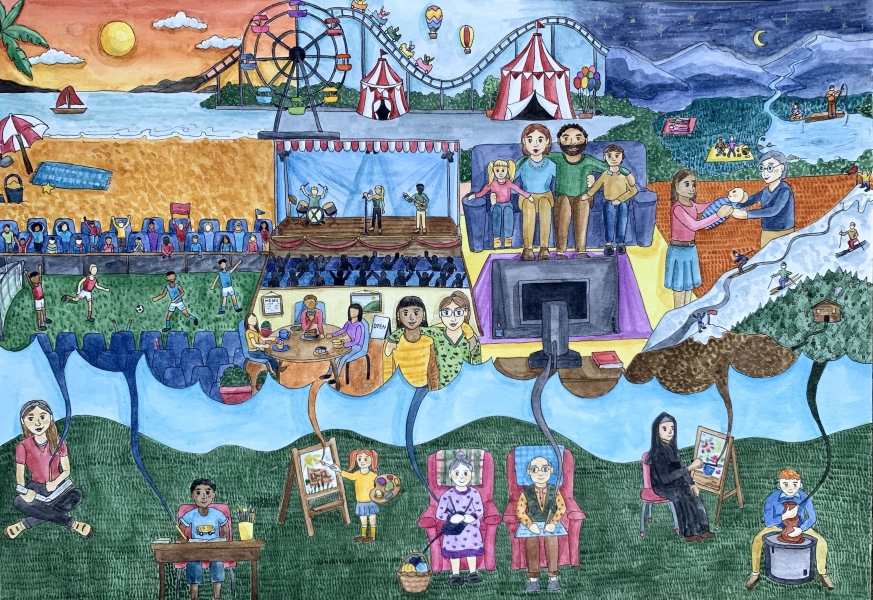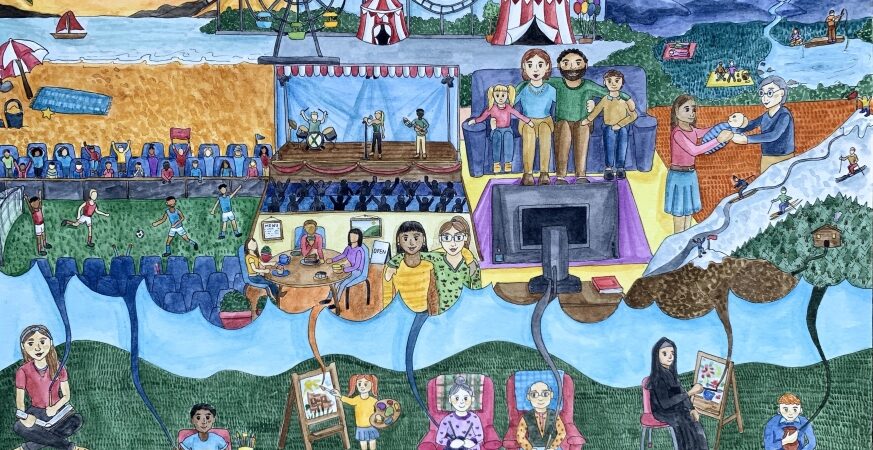
In this post, Dr Jane Hislop reflects on how to foster kindness and compassion in our academic culture in an authentic way. Jane is Director of the PG Certificate in Simulation Based Clinical Education and senior lecturer in medical education in the Medical School. This post is part of the July-August Learning & Teaching Enhancement theme: Learning and Teaching Conference 2023↗️.
At this year’s Learning and Teaching Conference, Barbara Becnal’s mention of the cultural similarities between two unlikely social classes, the black gang leaders in the United States known as O.G.s (Original Gangsters) and the mostly white scholarly ‘elite’ primarily located in academic institutions in the Global North (Becnel, 2023), struck a cord. How interesting it was to hear about her 30 years of researching black youth gangs in California and her more recent PhD experiences. Working with Crips and Bloods, she discussed observing cultures of competitiveness and a lack of collegiality. She went on to argue that these observations translate across to academia and the ‘dys-care’ of doctoral students.
I had been thinking about this area for some time, and a colleague suggested reading The Thesis Whispers’ blog posts↗️ written by Professor Inger Mewburn at The Australian National University: ‘Academic assholes and the circle of niceness’↗️ (Mewburn, 2013) and ‘How NOT to be an academic asshole during Covid’↗️ (Mewburn, 2020). In these blog posts, Mewburn (2013, 2020) highlights the tendency of academics to sabotage or belittle colleagues and the ‘toxic positivity’ of academia where academics pretend everything is okay and are reluctant to admit when they are struggling. Mewburn (2013) suggests a need for creating ‘circles of niceness’ and asks the question: how can we make academia a kinder place to work?
Talk of a ‘toxic culture’ in academia is not new and much has been published in this area (Mahmoudi, 2019; Rawlins, 2019; Keashly, 2023). In their PhD thesis, Aranda (2018) discusses the idealised image of academia as a place which promotes a culture of collegiality, academic freedom and autonomy. However, behind closed doors the perception of limited resources both monetarily and intellectually, means that purposeful incivility and even bullying of colleagues can occur. Among the many articles published in this area, Keashly and Neurman (2010) discuss workplace aggression and bullying seen across higher education and Pruit et al (2021) discuss toxic masculinity and the normalised occurrence of ‘status silencing’ of feminised others in academia.
Surprisingly, the ‘toxic culture’ of academia has been discussed in relation to healthcare professions’ education, including medical sciences (Elliott, 2022) and nursing (Thompson and Darbyshire, 2013). In Philip Darbyshire’s and David Thompson’s paper, ‘Is academic nursing being sabotaged by its own killer elite?’ (2013), the authors highlight the ‘dark side’ of nursing academia. In their later 2021 editorial, Darbyshire and Thompson (2022) admit that they had in fact understated the role of the ‘killer elite’, which they argue culturally normalises incivility, ‘gaslighting’, bullying or malevolence.
While much research has highlighted issues of incivility and bullying in academia, the question is: what can we do to make academia a kinder place to work? In their systematic review of incivility in academia, Park and Kang (2023) make recommendations for improving academic culture through educating faculty in respectful communication skills, and through introducing mentoring programmes for new faculty. Clearly et al (2013) also discuss steps to promoting integrity in the academic workplace.
When reflecting on the conference with my colleague, Dr Marti Balaam, Director of the Compassion Salon (The Compassion Salon, 2023), Marti highlighted the research around compassion and self-compassion and the benefits that acts of kindness can bring to both the receiver and giver. Evidence suggest that acts of kindness can trigger our parasympathetic nervous system to calm us (Balaam and Harris, 2021) releasing endorphins (natural opiate-like substance) and oxytocin, a hormone associated with caring (Ballatt and Campling, 2011). This calming of our nervous system is essential for our mental and physical well-being. It can help to promote and strengthen our communities, increasing our sense of belonging, enabling more meaningful relationships and unconditional positive regard for each other (Balaam and Harris, 2021).
In terms of ‘toxic positivity’, it was also raised at the conference that we need to be thinking not only about students’ well-being but supporting the well-being of staff, particularly at a time when many are struggling. The University of Edinburgh offers a plethora of well-being support for both staff and students, and much excellent work is being done in this area and in the area of self-compassion. Alongside this, we might want to think about how we, as individuals, can foster a culture that makes academia a kinder place to work. The Random Acts of Kindness website↗️ gives some useful pointers on steps to take to create a workplace culture where people feel connected, have a sense of purpose which in turn makes for a stronger more successful organisation. Despite profound effects on our well-being, these steps are simple and take up little time when incorporated in to our everyday lives. They include positive role modelling, respectful behaviour, kind and considered communication and collaboration, amongst others.
In conclusion, if we want to create a kinder place to work, where academics, students and the organisation can benefit, it starts with each one of us walking the talk, by being kind to ourselves and others and creating our own circles of niceness. In doing this, we might just create a kinder place to work where we can all thrive and grow.
References
- Aranda, J. L. (2018) ‘Civility and Bullying in Higher Education : Secrets in Academia and the Culture of Incivilty’, (May), p. 141.
- Balaam, M. and Harris, H. (2021) ‘Burnout, Mistreatment and Stress’, in Dent, J. A. et al. (eds) A Practical Guide for Medical Teachers. 6th ed. London: Elsevier, pp. 369–375.
- Ballatt, J. and Campling, P. (2011) Intelligent Kindness. Edinburgh: Royal College of Psychiatrists.
- Becnel, B. (2023) ‘Transcending the “ Dys-Care ” of Doctoral Students : Assessing How Cultural Similarities Between the United States ’ Black Gangster Class and Academia ’ s Elite Adversely Influence Student Agency and Relevance in Knowledge Production’, pp. 22–35.
- Cleary, M. et al. (2013) ‘Promoting integrity in the workplace: A priority for all academic health professionals’, Contemporary Nurse, 45(2), pp. 264–268. doi: 10.5172/conu.2013.45.2.264.
- Darbyshire, P. and Thompson, D. R. (2022) ‘Killing us softly with their wrongs: Nursing academia’s “killer elite” continue unabated’, Journal of Nursing Management, 30(1), pp. 1–3. doi: 10.1111/jonm.13391.
- Elliott, G. E. (2022) ‘Basic Sciences Medical Faculty and Their Challenges to Compassionate Teaching’, The European Journal of Social & Behavioural Sciences, 31(3), pp. 222–235. doi: 10.15405/ejsbs.324.
- Keashly, L. (2023) ‘When faculty are bullied: the unacceptable costs of doing our job and what universities can and should do’, FEBS Letters, 597(3), pp. 339–343. doi: 10.1002/1873-3468.14564.
- Keashly, L. and Neuman, J. H. (2010) ‘Faculty Experiences with Bullying in Higher Education’, Administrative Theory & Praxis, 32(1), pp. 48–70. doi: 10.2753/atp1084-1806320103.
- Mahmoudi, M. (2019) ‘Academic bullies leave no trace’, BioImpacts, 9(3), pp. 129–130. doi: 10.15171/bi.2019.17.
- Mewburn, I. (2013) Academic assholes and the circle of niceness, The Thesis Whisperer. Available at: https://thesiswhisperer.com/2013/02/13/academic-assholes/ (Accessed: 17 July 2023).
- Mewburn, I. (2020) How NOT to be an academic asshole during Covid, The Thesis Whisperer. Available at: https://thesiswhisperer.com/2020/07/08/lets-just-stop-it-with-the-toxic-positivity/ (Accessed: 17 July 2023).
- Park, E. J. and Kang, H. (2023) ‘Faculty-to-faculty incivility in nursing academia: A qualitative systematic review’, Journal of Professional Nursing, 48(September 2022), pp. 1–14. doi: 10.1016/j.profnurs.2023.05.006.
- Pruit, J. C., Pruit, A. G. and Rambo, C. (2021) ‘“Suck It Up, Buttercup”: Status Silencing and the Maintenance of Toxic Masculinity in Academia’, Studies in Symbolic Interaction, 52(2021), pp. 95–114. doi: 10.1108/S0163-239620210000052007.
- Random Acts of Kindness (2023) Steps to Creating Kindness in the Workplace, Random Acts of Kindness Foundation. Available at: https://www.randomactsofkindness.org/work/RAK_7_steps_to_create_kindness_in_the_workplace.pdf (Accessed: 17 July 2023).
- Rawlins, C. M. (2019) ‘The ivory tower of academia and how mental health is often neglected’, Future Science OA, 5(4). doi: 10.4155/fsoa-2019-0032.
- The Compassion Salon (2023) The Compassion Salon. Available at: www.compassionsalon.co.uk (Accessed: 17 July 2023).
- Thompson, D. R. and Darbyshire, P. (2013) ‘Is academic nursing being sabotaged by its own killer elite?’, Journal of Advanced Nursing, 69(1), pp. 1–3.
 Jane Hislop
Jane Hislop
Dr Jane Hislop is Director of the PG Certificate in Simulation Based Clinical Education and senior lecturer in medical education in the Medical School. Jane teaches on online distance-learning programmes for those involved in undergraduate and post-graduate education of health professionals (including qualified doctors, nurses, dentists, pharmacists, and allied health professionals). In addition, Jane works part-time as a Clinical Education lead in Musculoskeletal Physiotherapy within NHS Fife Scotland. Jane has a particular interest in peer assessment and feedback, as well as Simulation methodology. You can find Jane on Twitter at @hijanehislop↗️.
 Niamh Ní Iceadha
Niamh Ní Iceadha
Niamh is a Masters student studying comparative education and international development at Moray House. They are a qualified primary school teacher and love art, education and art education! They enjoy creating with a range of media, in particular illustration with fine liners and watercolours, ceramics and polymer clay jewellery.
Instagram: @primroseandfern↗️


